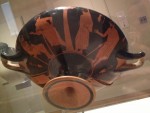Red-Figure Vase Firing Stages Illustrated


Santa Barbara Painter
Greek
Red-figure Kylix (wine cup), 480-460 BCE
ceramic
5 1/8 × 12 5/8 in.
SBMA, Gift of Wright S. Ludington
1955.3.5
COMMENTS
Greek Terra Cotta Pottery
The black-figure technique of ancient Greek vase painting had its origins in Corinth during the Oriental period (700-600 BCE) and achieved maturity in the hands of Athenian potters during the first 70 years of the Archaic period (600-480 BCE). Athens eclipsed Corinth for two primary reasons: the larger Attic vessels afforded space for more intricate decoration and the Attic clay was superior, yielding a more lustrous black gloss and a new orange-red color for the unglossed surfaces.
The gloss (or slip) consisted of a thin layer of clay mixed with water that was applied with brushes to create the figures that would be turned black during the firing process. Detail work was accomplished by using a sharp stylus to cut through the gloss and reveal the clay underneath. The firing process resulted in different chemical reactions for the glossed and unglossed areas. Oxygen in air that was let into the kiln fixed the entire vessel in red. The temperature was then raised and the flow of oxygen halted, causing the entire vessel to turn black. The glossed areas hardened to a deep, glass-like black while the more porous unglossed areas turned to a dark gray. Finally the kiln was allowed to cool slightly and oxygen was reintroduced. Areas not covered by gloss turned red again. The hardened areas covered by gloss did not absorb any more oxygen and retained their dark black luster. Note that no pigments were used. The two colors were consequences of different chemical reactions within the kiln.
Black-figure ware of the 6th century BCE depicted the rich lore of Attic mythology: gods and goddesses, heroes and monsters, and stories of Olympus and the Trojan War. Decorative elements of palmette, lotus, and meander framed the scenes. The style reached its apogee in 550-520 BCE in the hands of its greatest master, Exekias. Other famous black-figure potters included Kleitias, Ergotimos, Nearchos, Lydos, Andokides, Euthymides and Sopphilos.
Red-figure pottery used the same technology but reversed the process. The gloss was painted onto the negative spaces so the background was in black and the figures were in red. The consequence was that the detail work could be painted on with a fine brush dipped in gloss rather than be engraved. This gave the artists far greater control over outcomes, thus fueling experimentation and stylistic evolution. For more details, click the Firing Stages link above.
With a lighter surface to work on, Greek potters could now show greater anatomical detail in their figures and faces, including three-quarter profiles. From 500 BCE onwards the red-figure style dominated and the depictions became more and more naturalistic. Foreshortening was mastered. The subject matter was also enlarged to include scenes of everyday life in addition to the traditional heroic and mythical material. Major artists included Douris, Brygos and Onesimos.
The Classical period (480-330 BCE) saw a continuing decline in the quantity and quality of vase painting, probably due to its ever more trivial subject matter.
- Mike Ramey, Provisional Research Assignment, February, 2012
SBMA CURATORIAL LABELS
The scenes on this drinking vessel depict young men at school discussing music and rhetoric. The interior of the kylix shows two students locked in conversation while the exterior displays scenes from within the school itself, a portico represented by two Doric columns. Along the walls of the portico are lyres and a flute as well as a writing tablet and both columns are inscribed with the words "beautiful boy" (ho pais kalos). This is an example of red-figure ware because the figures are left the natural color of the clay while the background and details are rendered in black glaze.
- Art on the Human Scale, 2012
